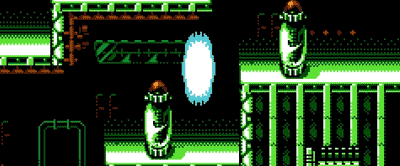
Tips for enjoying Street Fighter 2010: The Final Fight
Sep 14, 2014 // GregaMan
Street Fighter 2010: The Final Fight released recently on the Nintendo 3DS eShop, and I’m dead set on having people notice. So far, 100% of the times I’ve mentioned this game, someone has chimed in about how it was once panned in a comedy video series whose shtick is angrily panning video games. A more even-tempered examination of the game, however, will reveal that it is brimming with innovation, nuance, variety, and quality, and well worth your five bucks even if you didn’t pay the original asking price of…::does research::…5,800 yen. Holy cow. With that in mind, I present to you the following terribly important points about this game. I hope that they will help you get the most out of it and stop at least one of you from letting the foul-mouthed ranting of knee-jerk internet culture poison the well. Street Fighter 2010, if not a true Street Fighter game, is without question a true Capcom action game, with the same mad-scientist level of technicality we’d already all come to expect from the publisher even by just 1990. One more thing before I get into it though: I’ve taken some images and information from the Japanese fan site Game Kommander . In addition to a complete illustrated walkthrough of the game, the site features videos of high-level play, a complete detailed explanation of all of the game’s techniques, powerups, and enemies, scanned advertisements from the game’s marketing campaign in both Japan and North America, and several insightful essays on the topic of Street Fighter 2010. It is an incredible site, and quite probably the most work anyone has ever done pertaining to Street Fighter 2010 since the ragtag team of developers actually created it. I don’t know who runs this site, but I suppose I should put a handshake on my bucket list. Now then! Some things to know. 1. You have to master the backflip. This is the first thing you should know about the game, and it may not be very intuitive unless you’re used to Capcom action games. I have seen people criticize this game for being frustrating and never once mention the backflip mechanic, but the entire game is designed around the pretense that players will be using the backflip mechanic profusely. If you aren’t using it, you’re probably really frustrated. But don’t complain—learn! So here’s how it works: Step 1) Stand still. Step 2) Press jump. That’s the “A” button. Step 3) In midair, press Left or Right on the D-Pad—whichever is opposite the direction the player character is facing. Note that you cannot initiate the backflip if you are in the middle of running, since that will cause you to jump forward, at which point pressing the opposite direction on the D-Pad will just cause you to pull back the trajectory of your forward jump. Done correctly though, you will cause the player character (Ken Masters in the North American version!) to execute a glorious backflip, which both looks really cool and has a very important function: during the backflip animation, Ken is invincible. This is his, and your, primary form of defense. Use it aggressively. Use it often. Use it to jump through enemies and enemy projectiles. Don’t just dodge—attack the enemy with dodgingness!! ↑ An artist’s rendering. Woodblock print, c. 1784 It’s a really fun mechanic, and makes you feel like an acrobatic champ when you use it to adapt to all the crazy crap happening on screen. You can also adjust the trajectory of the flip while it’s being executed, giving you quite a bit of control over your own positioning. Compare to similar maneuvers like the dodge rolls in Monster Hunter, Lost Planet, or Devil May Cry—they all have invincibility frames, but none of them let you adjust the length or trajectory of the roll once you’ve initiated the animation. Advantage: Ken. Firing a plasma shot mid-backflip will cause Ken to execute a midair downward shot. I’m not saying this was the inspiration for Dante’s “Rainstorm” technique in Devils May Cry 2-mC; but it does look exactly like it. 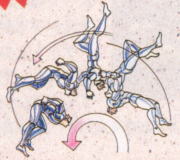
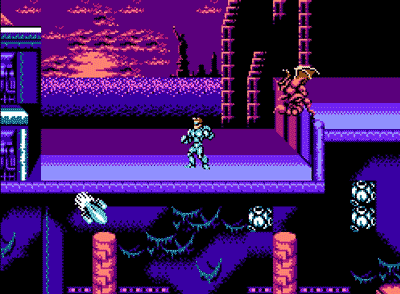
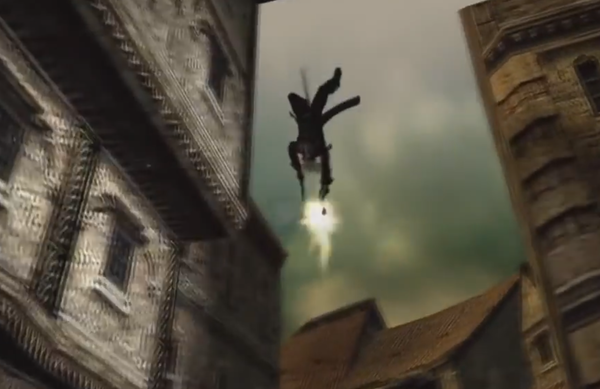
↑ And bear in mind, this is the coolest animation in Devil May Cry 2.
It also presents another strategic element, insofar as it gives the player an offensive option (this is the only way to shoot straight down) that requires you to commit to a jump. In practice, the backflip-downward-shot combo essentially works like a counter attack. Eat the damage and retaliate all in one smooth motion. And all this with the extremely limited input set of the NES controller.
As one final but significant point, the backflip can be upgraded with the acquisition of a Flip Shield Capsule. This makes it so your backflip actually causes damage to enemies, elevating the technique to God Tier. Pro tip: Try and maneuver the backflip to get multiple hits on an enemy in a single flip. Can be done!

2. Master all your other moves, too.
In Street Fighter 2010, you press Down and B to shoot a plasma blast diagonally up. I’ve seen people try miserably to come to terms with this. “To shoot up diagonally, you have to press down and B,” one amazon.com reviewer notes. “I am so glad you don’t actually need to use this attack ever!” This reviewer also describes the game as “the best game I have ever played,” so I’m glad it didn’t kill the experience for him. But there are two things I want to stress here:
- Learning a new input in an NES game, even one that may not seem intuitive, takes approximately one second. Complaining about it, on average, takes at least five. In one popular video review of the game, the reviewer dedicates fifteen seconds. My goodness.
- This input is only counterintuitive if you are thinking only of the direction of the shot: “Why press down to shoot in an upward trajectory?” But remember, Ken Masters is a martial artist. Don’t act surprised. The plasma shots he fires in this game are all powered by the force of his punches and kicks. Press B to do a simple jab, shooting the plasma straight ahead. Press Up and B to punch upward, shooting plasma straight above you. Press Down and B to do a roundhouse kick using the lower extremities. If you’ve studied martial arts in any capacity, you probably know that a roundhouse kick is a technique by which the practitioner swings his/her leg diagonally up and forward. If the foot were to emit a plasma ray that continued along the trajectory of the kick, the ray would shoot out diagonally up. But the executer of the attack is of course still aware that he/she is using the lower extremities to perform the maneuver. There’s the logic. Need more convincing? Well, strictly from a user experience standpoint, holding Down (or any cardinal direction) on the D-Pad is a whole lot more comfortable than holding a diagonal, and holding a diagonal would also increase the likelihood of the player accidentally stepping forward, which, in addition to being quite lame, would also make it harder for the player to bust out the backflip, since, as we’ve established, you can’t do the backflip while you’re moving forward. Please RT.

↑ The Angry Video Game Nerd on the controls: “It’s as if the controls themselves are too futuristic and advanced for anyone to comprehend.” While that would be a very cool case of ludonarrative resonance, I’m afraid it simply isn’t true. Ten to sixty seconds of attentive play should be all it takes to get the basic controls down.
Once you’ve gotten all that sorted out, you will discover that the kick does serve its purpose. It’s one of Ken’s most powerful attacks, and it allows you to attack a high position from a low position. When leveled up, it has a distinct, boomerang-like arc that allows you to attack enemies above and behind you. Learn that trajectory!
Additionally, did you know that the kick is actually part of a powerful, four-hit combo? Simply hold Down and press B four times to do a kick, kick, punch, punch series. The moves are slow, but deal heavy damage in relatively few shots.
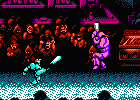
↑ Ken deals a swift kick to his opponent, the nefarious “Brian.”
Hold Forward while attacking to do a series of what’re known as “Hyper Shots.” Ken unleashes a barrage of slow and heavy hook punches that do big damage. Use it on bosses when you don’t have time to get a lot of regular shots in.
Jump and press B to do an acrobatic jump shot. The jump shot is a relatively safe way to do high damage. Use it to pick off little enemies when you find yourself in an area with precarious footing. It’s also the single quickest way to break destructible objects and uncover powerups.
Ken also has the ability to climb vines, walls, and columns. This mechanic is a bit nuanced, and I think it eludes people at first. To cling to a surface, you must hold A, the jump button. Once you’re clining, you can let go of A, but if you’re not holding A when you jump at a surface, you’ll just hit the surface and continue falling alongside it. This, too, can be mastered and used to your advantage. Try jumping at a climbable surface and intentionally falling to a strategic altitude before pressing A again to cling. This is particularly important in Area 2-2, which is entirely an auto-scrolling vertical climb. You can’t attack from a climbing surface unless you are at rest, which is hard to do when the murderous bottom edge of the screen fast approaches, so you’ll have to make masterful use of the cling mechanic to fake out the enemies as they home in on you. It may seem chaotic at first, but it can be done with just a bit of practice. Learn to climb; that’s why Area 2-2 exists.
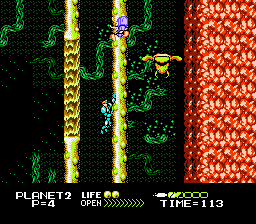
↑ Back when vines took more than six seconds.
3. Momentum is important.
In Street Fighter 2010, you collect powerups hidden in destructible objects. For every two powerups you collect, you gain one “level,” up to level five. The higher your level, the greater your attack range. This is of utmost importance. If you can maintain a high level, the game is infinitely easier since you can maintain a safer distance from all enemies. When your level is low, your plasma shots are barely longer than your limbs themselves, meaning you must get right up in the enemies’ highly treacherous grills to engage in deadly future-combat. In Street Fighter terms, it’s the difference between a hadoken and a fierce punch.
When you die in this game, your level is reset back to zero. Past level three, you lose a level each time you’re hit until you’re back down to level two. Effectively, this means that the worse you do, the worse you’ll do. If you’ve ever played Gradius then this will be a frustratingly familiar concept, but remember that this is all part of the game. Gaining levels as quickly and efficiently as possible becomes a top-priority concern. You’ll find yourself memorizing powerup locations and plotting out the safest positioning for taking out specific enemies. Don’t lose your momentum, or you’ll be pedaling uphill instead of coasting. Who didn’t love that metaphor?
4. All difficulty is surmountable, balanced.
In an essay from the previously linked Japanese page, the author describes Street Fighter 2010 as an “action game of the highest order,” but also “one of the most underrated Famicom games of all time.”
The author attributes this to two specific reasons:
- “It confusingly wears the Street Fighter moniker, which speaks nothing to the game’s incredible level of polish.”
- “The high level of difficulty.”
It’s easy enough to understand the first reason. A lot of people discovered this game after the Street Fighter boom ignited by Street Fighter II’s release in 1991, and were disappointed to discover the complete lack of resemblance. It’s important to stress, though, that 2010 actually came out a year before the SFII boom, when the identity of the Street Fighter brand was still up in the air. Remember that the originally planned follow-up to the original Street Fighter was a side-scrolling beat-‘em-up called Street Fighter ’89—later renamed Final Fight. As it stood in 1990, Street Fighter 2010 was in fact the second of just two Street Fighter games. The divergence of style was hardly remarked upon at the time.

↑ Can you believe characters like Cody, Guy, and Poison were almost in a Street Fighter game??
Regarding reason number two, the above author says the following:
“It’s true that 2010 is likely one of the most difficult games in the Famicom’s massive library. But to be sure, by no means is that an unreasonable difficulty caused by insufficient testing or lack of balance.
Even the most severe sections of the game have winning strategies, and the game is made such that, with enough practice and repetition, you will see the end. Dig even deeper and you’ll find that the game is so delicately balanced that you’ll eventually be able to pull off perfect runs. This is not an unclearable game.”
By design, a lot of the enemy behavior in this game is based on procedural algorithms, which means there’s an element of randomness each time you play, but also that that randomness has a logic to it. Be thoughtful in your approach, be ready to adapt to the situation using all the tools you’ve been given, and you’ll get through it eventually.
5. This game boasts a serious staff pedigree.
-Designer: Miata Yamamoto – Ghouls ’n Ghosts (Arcade), UN Squadron (SNES), Magical Quest Starring Mickey Mouse (SNES)
-Programmer: H.M.D. – Mega Man (NES), Mega Man 2 (NES)
-Composer: Tamie – Bionic Commando (NES), Strider (NES), Sweet Home (NES)
I mean come on.
6. The game has you traveling across five planets, and each one has an actual cohesive motif.
I just think this is cool. Every few stages you jump to a new planet, but each planet has a cohesive concept—one is overrun with vegetation; another is a desert; another is cold, sterile, and mechanical. It’s easy to get distracted by the game’s high difficulty and miss it, but it’s cool how much work and thought went into actually connecting these bite-sized worlds with a sort of visual consistency.
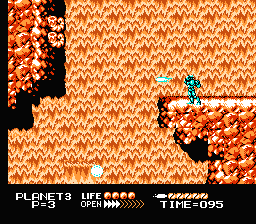
↑ Scenes from the desert planet.
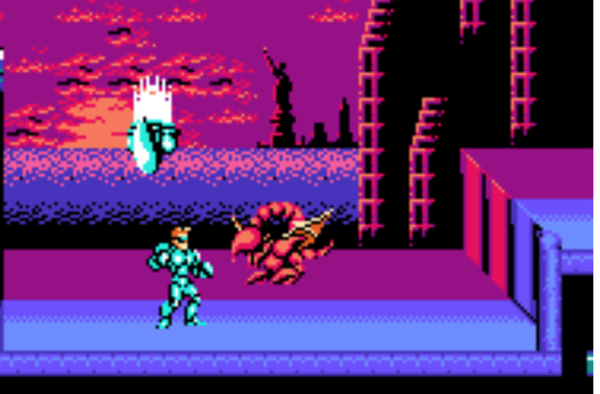
↑ Wait a minute…Statue of Liberty….That was our planet!!
7. Here’s what high-level play looks like. Watch and learn.
Planet 1
In closing, I leave you with one final quote from GAME KOMMANDER:
It’s not a game with low barrier of entry. It’s not a game for the mainstream. But it is without question a masterpiece. Among those who have cleared it, 2010 is frequently heralded as one of action gaming’s best. See for yourself how unembellished that statement truly is.
I tend to agree! Check it out, guys—it’s pretty neato.
-
Brands:Tags:
-

Loading...
Platforms:
